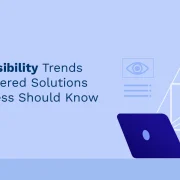
Flex to HTML5 Migration: A Quick Guide
In 2017, Adobe announced that it would end support for its Flash plug-ins by 2020. This was followed up by announcements from Microsoft and Google, declaring that the plug-in will be disabled by the end of the year. Since Flex applications run on this plug-in, IT heads and product managers are now compelled to migrate these legacy apps to more future-ready platforms. One of the obvious choices for this has been Flex to HTML5 migration.
This is primarily due to the more versatile and flexible nature of open standard techs like HTML5. Faster operations, scope to add all conceivable multimedia elements, time and cost-effectiveness, freedom from proprietary systems, and scalability are some of the top reasons why HTML5 has emerged as a preferred alternative to Flex.
Know More: Flash to HTML5 Conversion
If you too have been contemplating a shift, this Flex to HTML5 migration guide will make the transition easy for you. Flex to HTML5 Migration Assessment Once you have decided to migrate your applications to HTML5, it is important to prioritize which apps will be the first to go through this transition. To do that, you need to evaluate the value of each app for your business operations on the following criteria:
1. Value to Business
Assess the value each app brings to your business. For this, stakeholders of the business and tech side of operations must work together closely. The idea is to evaluate the role of each app in meeting your business goals in the immediate and distant future. Based on that, you can line them up in the order in which they must be migrated.
2. Multi Channel Value
The next parameter is the value of your apps on multiple channels. Is an existing app fit for a modern framework? Would make it available on mobile devices across operating systems add more value to the business? Quantify it using tangible parameters such as ROI, revenue growth, as well as customer retention and adoption.
Know More: Flash to HTML5 conversion services
3. Assess Security Risks
Flex applications are notorious for being vulnerable to cross-site scripting, which exposes them to a host of security risks. So, you need to explore if any of your applications are more susceptible to attacks than others. Or if any of your apps have been attacked in the past?
Account hijacking via cookies, account theft by changing page content, and vulnerability due to security holes in the Flash plug-in are some of the common security concerns that need to be assessed when ranking apps on their robustness.
Know More: Fast-tracking Flash to HTML5 Conversion
4. Complexity of Migration
When making the transition from Flex to HTML5, consider the complexity of the migration process for individual apps. Here, you must factor in all the major adjustments that will be required once your app moves to the HTML5 framework and not just the technical aspect of it. Sit with your technical team to understand how moving to a new platform would impact your business.
5. Risk Vs. Value
Now that you have finished the assessment of apps, evaluate the results from a risk versus value standpoint. Of course, apps with high value and low risk are best suited for your Flex to HTML5 migration initiative. In case the parameters indicate high risk and low value for an app, it’s best to let go of it and replace it with a new one designed to fit modern UI frameworks. How to Convert Flex to HTML5? You have now identified which apps should go through the migration process first. Businesses that have only a single application can use this process to determine whether or not it is viable for Flex to HTML5 migration.
Once that decision has been taken pragmatically, you have to begin the transition process. These are the essential steps to bear in mind to make the shift as seamless and efficient as possible:
Step 1 – Assimilate All Source Files
Start by assimilating all the media and supporting files before you begin the conversion process. This includes Flash files, data files, JavaScript as well as media files. Having all the necessary materials in one place ensures quick and effective migration. By exercising due diligence at this stage, you can rule out the risk of losing out key elements in transition.
Step 2 – Extract Content
Once all the necessary files are in place, the process of extracting content, media, and coding information from your legacy application begins. It helps to copy the front-end content as well as navigation buttons used in the GUI (or graphical user interface) and save them in the form of a storyboard. This can become a useful point of reference during your Flex to HTML5 migration.
In addition to this, all the multimedia elements need to be structured and stored in earmarked folders.
Step 3 – Select a Conversion Tool
While complete automation of the migration process is difficult to apply when migrating applications from Flex to HTML5, businesses do have the option to automate this process partially. There are tools such as Google Swify, Sencha, and Adobe CreateJS that can make this transition smooth, without compromising the interactive or visual elements of the legacy app.
It would help if you researched these tools to understand which one is best suited to your requirements before making a choice.
Step 4 – Decide on Interactive Elements
Once migrated to HTML5, an application will not be identical to its legacy Flex version. This is a great opportunity for you to incorporate the latest interactive elements into its interface, making it fit for a modern UI framework. From complex animations to high-end graphics, there are plenty of options to choose from.
However, don’t go overboard just because you have options. Pick and choose sensibly, keeping in mind the purpose of the application and the requirements of your target users.
Step 5 – Create a Beta Version
Once all the details are in place, it’s time to create and test the beta version of your application. This version must resemble the real application as closely as possible so that your stakeholders and a select group of users can get a sense of the look and feel of the actual product.
This is also the stage where you make tweaks, alterations, and improvements to the migrated application, eliminating any bugs and enhancing its user-friendliness. This helps reduce reworks later on.
Step 6 – Launch
The migration of your legacy application from Flex to HTML5 is now complete. You can now finish the transition process using the migration tool of your choice and release your application in its all-new avatar!
The Way Forward
This step-by-step guide for deciding which application to migrate from Flex to HTML5 and how to do it will assist you at every step of the way in your journey from a proprietary platform to a modern universal framework. Based on these, you can devise your tailor-made migration process, keeping in mind your future goals, plans, roadmap, and budget.
Need to know more about our Products & Services? Drop us a note at marketing@hurix.com.




